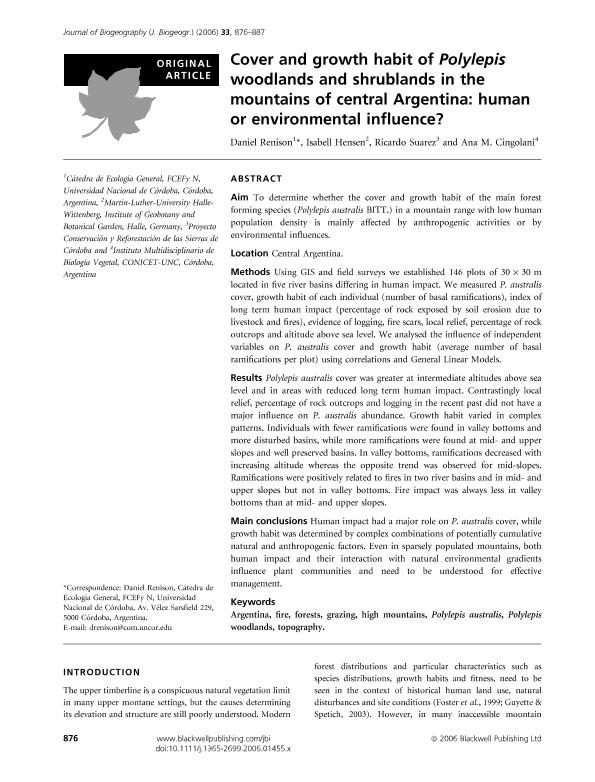Mostrar el registro sencillo del ítem
dc.contributor.author
Renison, Daniel

dc.contributor.author
Hensen, Isabell
dc.contributor.author
Suarez, Ricardo
dc.contributor.author
Cingolani, Ana María

dc.date.available
2018-09-05T18:15:57Z
dc.date.issued
2006-05
dc.identifier.citation
Renison, Daniel; Hensen, Isabell; Suarez, Ricardo; Cingolani, Ana María; Cover and growth habit of Polylepis woodlands and shrublands in the mountains of central Argentina: Human or environmental influence?; Wiley Blackwell Publishing, Inc; Journal of Biogeography; 33; 5; 5-2006; 876-887
dc.identifier.issn
0305-0270
dc.identifier.uri
http://hdl.handle.net/11336/58394
dc.description.abstract
To determine whether the cover and growth habit of the main forest forming species (Polylepis australis BITT.) in a mountain range with low human population density is mainly affected by anthropogenic activities or by environmental influences. Location: Central Argentina. Methods: Using GIS and field surveys we established 146 plots of 30 x 30 m located in five river basins differing in human impact. We measured P. australis cover, growth habit of each individual (number of basal ramifications), index of long term human impact (percentage of rock exposed by soil erosion due to livestock and fires), evidence of logging, fire scars, local relief, percentage of rock outcrops and altitude above sea level. We analysed the influence of independent variables on P. australis cover and growth habit (average number of basal ramifications per plot) using correlations and General Linear Models. Results: Polylepis australis cover was greater at intermediate altitudes above sea level and in areas with reduced long term human impact. Contrastingly local relief, percentage of rock outcrops and logging in the recent past did not have a major influence on P. australis abundance. Growth habit varied in complex patterns. Individuals with fewer ramifications were found in valley bottoms and more disturbed basins, while more ramifications were found at mid- and upper slopes and well preserved basins. In valley bottoms, ramifications decreased with increasing altitude whereas the opposite trend was observed for mid-slopes. Ramifications were positively related to fires in two river basins and in mid- and upper slopes but not in valley bottoms. Fire impact was always less in valley bottoms than at mid- and upper slopes. Main conclusions: Human impact had a major role on P. australis cover, while growth habit was determined by complex combinations of potentially cumulative natural and anthropogenic factors. Even in sparsely populated mountains, both human impact and their interaction with natural environmental gradients influence plant communities and need to be understood for effective management.
dc.format
application/pdf
dc.language.iso
eng
dc.publisher
Wiley Blackwell Publishing, Inc

dc.rights
info:eu-repo/semantics/openAccess
dc.rights.uri
https://creativecommons.org/licenses/by-nc-sa/2.5/ar/
dc.subject
Argentina
dc.subject
Fire
dc.subject
Forests
dc.subject
Grazing
dc.subject
High Mountains
dc.subject
Polylepis Australis
dc.subject
Polylepis Woodlands
dc.subject
Topography
dc.subject.classification
Otras Ciencias Biológicas

dc.subject.classification
Ciencias Biológicas

dc.subject.classification
CIENCIAS NATURALES Y EXACTAS

dc.title
Cover and growth habit of Polylepis woodlands and shrublands in the mountains of central Argentina: Human or environmental influence?
dc.type
info:eu-repo/semantics/article
dc.type
info:ar-repo/semantics/artículo
dc.type
info:eu-repo/semantics/publishedVersion
dc.date.updated
2018-08-13T17:05:51Z
dc.journal.volume
33
dc.journal.number
5
dc.journal.pagination
876-887
dc.journal.pais
Reino Unido

dc.journal.ciudad
Londres
dc.description.fil
Fil: Renison, Daniel. Consejo Nacional de Investigaciones Científicas y Técnicas. Centro Científico Tecnológico Conicet - Córdoba. Instituto de Investigaciones Biológicas y Tecnológicas. Universidad Nacional de Córdoba. Facultad de Ciencias Exactas, Físicas y Naturales. Instituto de Investigaciones Biológicas y Tecnológicas; Argentina
dc.description.fil
Fil: Hensen, Isabell. Institute of Geobotany and Botanical Garden; Alemania
dc.description.fil
Fil: Suarez, Ricardo. Proyecto Conservación y Reforestación de las Sierras de Córdoba; Argentina
dc.description.fil
Fil: Cingolani, Ana María. Consejo Nacional de Investigaciones Científicas y Técnicas. Centro Científico Tecnológico Conicet - Córdoba. Instituto Multidisciplinario de Biología Vegetal. Universidad Nacional de Córdoba. Facultad de Ciencias Exactas Físicas y Naturales. Instituto Multidisciplinario de Biología Vegetal; Argentina
dc.journal.title
Journal of Biogeography

dc.relation.alternativeid
info:eu-repo/semantics/altIdentifier/url/https://onlinelibrary.wiley.com/doi/full/10.1111/j.1365-2699.2006.01455.x
dc.relation.alternativeid
info:eu-repo/semantics/altIdentifier/doi/http://dx.doi.org/10.1111/j.1365-2699.2006.01455.x
Archivos asociados
